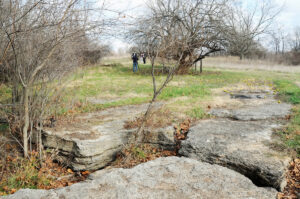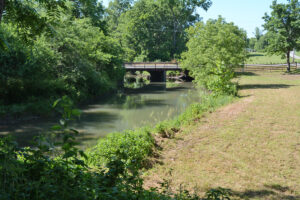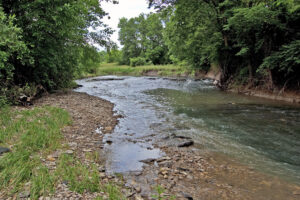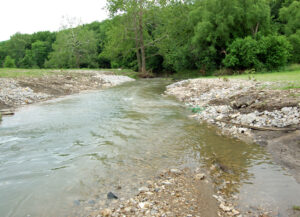Rush Creek, Sidney Gilbert Farm Site

On June 24, 1834 following the violent storm near Fishing River, several days of rest at the farm of John Cooper, and the reception of what is now Section 105 of the Doctrine and Covenants, it was time for the members of Zion’s Camp to move again. They took up their march toward Liberty, Clay County, until they were advised by David R. Atchison not to go there. Consequently, they stopped at the home of Algernon Sidney Gilbert on the banks of Rush Creek. Some members of Zion’s Camp established headquarters at the Gilbert home while many others settled on property owned by George Burket. The exact location of that site is not known at present.

Later, on that very day, some members of the camp started feeling ill due to the effects of cholera. Max Parkin reports that cholera is “a disease of the digestive tract and was often a frightful malady of the sometimes unsanitary frontier.” According to Alexander L. Baugh, cholera can advance so rapidly that one can feel fine at a given moment, then experience excruciating pain and finally pass away from the disease all in a matter of hours.

John S. Carter, a former Baptist minister, was the first of the group to die as a result of the disease. Ultimately, thirteen camp members, including one woman, and two local Saints, succumbed to the vicious symptoms. The two who succumbed but were not members of Zion’s Camp were A. Sidney Gilbert and Phebe Murdock, the six-year-old daughter of John and Julia Murdock. Phebe was sister to the twins who were adopted by Joseph and Emma Smith in 1831. She had been living with the Gilbert family but her father, John Murdock, was present when she passed away. He buried her on Sunday, July 6, the day she died. More than sixty others, including Joseph Smith, became ill but did not die.
Alexander Baugh writes that news of the outbreak at Rush Creek “spread quickly, and the reports sent shockwaves among the local residents of Liberty and elsewhere.” It has been suggested that the fear of cholera may have been a factor in preventing the mobs from following up on their threats to attack Zion’s Camp. They chose, instead, to stay as far away as possible. Max Parkin notes that the outbreak of the disease deepened the animosity of the locals against the Saints.
As noted above, the site of the Burket property is unknown but the burial site of at least three of the victims has been identified. It is located on a farm that in 2019 was owned by a member of The Church of Jesus Christ of Latter-day Saints.

Map and Location
For those interested in visiting the site, Max H Parkin listed the following directions: “Travel east from Liberty on Mill Street (one block south of the courthouse). On Mill Street cross State 33 (Lightburn Street) and continue three blocks to a traffic light 9.6 mile from the courthouse). Here, Highway H, the old pioneer road, curves left to Excelsior Springs and to Latter-day Saint sites in the eastern part of the county. Turn right at the traffic light and continue on Mill Street, which quickly becomes Richfield Road. From the light, go east 1.4 miles to a bridge that crosses stream. This stream is Rush Creek.”
Ownership Status
While the road crossing Rush Creek is public, the land around it is privately owned and should be respected, particularly the burial site which is several hundred yards into the property. Stopping even to take a quick photograph by the stream is challenging because of safety concerns so care must be taken if one wishes to do so.
Photos



Articles & Resources
References and Resources
Max H Parkin, in LaMar C. Berrett, ed., Sacred Places Volume 4, 195-199.
Alexander L. Baugh, in Matthew C. Godfrey, ed., Zion’s Camp, 1834 March of Faith, 79-85.
Andrea Radke-Moss, in Matthew C. Godfrey, ed., Zion’s Camp, 1834 March of Faith, 122-125.
Kenneth R. Mays, “On the Road With Zion’s Camp,” Mormon Historical Studies, Spring/Fall 2007, Vol. 8, Nos. 1-2, 72.
